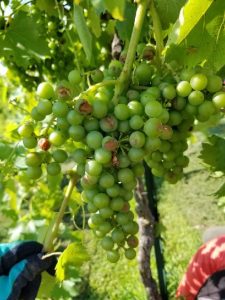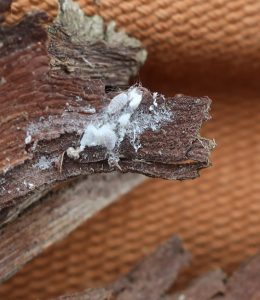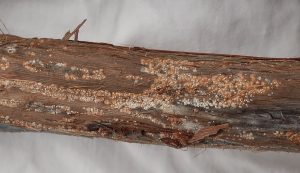Published on
Updated on
Contents:
- Split and Cracked Berries
- Grape Scale and Grape Mealybug
- Report Herbicide Drift Damage to Grape Crop to Missouri Department of Agriculture
- Cumulative Growing Degree Days for the Seven Grape Growing Regions of Missouri from April 1 to July 3, 2023
Split and Cracked Berries

Photo credit: Submitted.
Some growers are reporting split or cracked berries after rainfall events and or hail (Figure 1). Berry splitting or cracking can occur from weather related conditions and from physiological disorders. When trying to determine what caused the damage take the following into consideration.
If split or cracked berries are only found on the front side of a cluster and only on one side of trellised grapevines, then damage can be attributed to a hail event. Also look at the leaves, hail damaged leaves typical have holes and appear tattered.
If split or cracked berries are found distributed throughout the cluster on both sides of a trellised grapevine, then damage could be attributed to a number of physiological or weather-related events. For example, high temperature weather results in berries having thin skins. Grapes under drought conditions, followed by high rainfall, results in the grapevine taking up more water resulting in cracked berries. For more information, read the article below.
In short, some of these damaged berries will dry up and fall to the ground. Some berries will scar and heal-over. However, keep an eye on split or cracked berries for disease development.
Berry cracking
In most all cases of early season berry cracking, the cracking of berries is the result of environmental factors interacting with the berries.
Three main environmental factors have a role in berry cracking. High berry temperatures result in reducing the strength of the berry skin, the berry expands, and the berry skin surface area shrinks. This results in berry cracking. Berry clusters that are shaded by the canopy often do not experience berry cracking as the canopy reduces berry temperature.
High relative humidity, especially at night, can result in berry cracking. During the nighttime, plant transpiration from the grapevine leaves is reduced compared to the daytime. At nighttime, the grape berries continue to transpire, and this increases turgor pressure on the berry skins and results in berry cracking. During the day, the leaves are transpiring high amounts of water and this lessons the turgor pressure on the grape berry skins.
Rain or heavy dew can induce berry cracking. Water can enter the berry by root uptake via transpiration. In vineyards that have experienced a drought period followed by a heavy rainfall event, this can result in increased turgor pressure on the berry skin, resulting in cracking. Water can also enter a berry by two other mechanisms. Water can enter a berry by moving across the berry skin, or water can enter from the berry stem receptacle with the water moving in due to transpiration of the berry. At present time, the mechanism causing the water to move into the berry from receptacle has not been elucidated.
Other factors have been identified that cause fruit cracking besides environmental conditions. Powdery mildew infections on the berry skins cause microfractures in the cuticle, making the berries prone to cracking. Calcium deficiency has also been implicated in berry cracking. Calcium is important in maintaining the integrity of cell membranes. In addition, calcium plays a role in the membranes structure and regulates water permeability of the membrane. When calcium is deficient, cell membranes deteriorate.
Good viticulture practices that begin with site selection will often alleviate berry cracking. Vineyard sites that shed water quickly and have well-drained soils will lessen the impact of large rainfall events. Limiting canopy management, especially the removal of leaves that exposes fruit berries to intense sunlight and high temperatures, can reduce berry cracking. Monitoring grapevine calcium levels at bloom can determine if a calcium deficiency exists. Calcium deficiencies can be corrected with foliar applications of calcium. Berry cracking can also be inherit to a cultivar such as Vignoles, which the berries often crack near harvest as a result of a rainfall event.
Bottom line: Management of split or cracked berries
- Important to watch for potential disease-rot development. I surmise that early season split or cracked berries will likely drop from the cluster or scar-over and heal.
- If rot develops, consider applying a strobilurin fungicide if needed such as Pristine. Reminder strobilurins should only be applied no more than two times during the growing season and never consecutively.
Grape Scale and Grape Mealybug
- The destructive stage of grape scale and grape mealybug remain hidden under the grapevine bark.
- Both insects require different management strategies.
- Although some insecticides are efficacious of both pests, management requires targeting pesticide applications at different life stages of these pests.
These two insects share a lot in common. Both can be found on grapevines but seldom are they readily apparent to the naked eye. First, the bark needs to be peeled away from the trunk or cordon to reveal the insects (Figure 2). If these insects are apparent, the insects you are seeing are female. These females have piercing sucking mouthparts and feed on the grapevine’s plant sap. The males of both these insects are winged and look completely different compared to the females, which is called sexual dimorphism.
Both of these insects need different management strategies. The grape mealybug is managed by monitoring the male flights using pheromone traps. There are two periods during the growing season when males are in flight searching out unfertilized female mealybugs. These two time periods represent two generations per growing season. During these two flight periods, mating can be disrupted by applying an insecticide (Table 1). For more information on the male flight timing, see the link at the end of the article.

Various management strategies can help the grape scale. First, be aware that scale insects have a large contingent of other insects that attack and kill them. It is important to preserve these natural enemies by selecting pesticides that are not broad spectrum. Superior oil can be applied prior to bud break to the trunks and cordons. The application of Superior oil needs to saturate the trunks and cordons. Superior oil is efficacious by reducing oxygen uptake and disrupting the cellular membranes of the scales. Superior oil preserves the natural enemies.

Photo credit: Dean S. Volenberg.
The next strategy for controlling the grape scale is to apply an insecticide when the first instar or crawler stage is present. The first generation crawler or spring generation begins to emerge at 274 degree days (DD) (base 50 F) with peak crawler emergence at 356 DD (base 50 F) with DD being accumulated from April 1. The second generation crawler or summer generation begins to emerge at 1166 DD (base 50 F) with peak crawler emergence at 1541 DD (base 50 F) with DD being accumulated from April 1. Besides monitoring degree days, apply double-sided tape around trunks of grapevines that have known grape scale to monitor for crawlers.
Insecticides for controlling grape scale crawlers: Carbaryl (Sevin XLR)
The following insecticides — Applaud 70DF, Movento 2SC, Admire Pro, and Assail 30 SG — should control grape scale crawlers but the label does not specifically list grape scale. Additionally, the pyrethroids (Baythroid, Mustang Max, Danitol and others) should control grape scale crawlers. Knack is an insect growth regulator that suppresses embryogenesis of insect eggs and has no activity on adult insects.
Application timing that targets the crawler stage of the grape scale is critical.
ViNews article for more information on grape scale: Scale Diaspidiotus Uvae: An Inconspicuous Grape Pest
ViNews article for more information on grape mealybug: Mealybugs in Mid-Missouri Vineyards
Table 1. Insecticides for the control of mealybugs in grapes.
| Trade name | Chemical name | IRAC | Target pest | Efficacy1 |
|---|---|---|---|---|
| Applaud | Buprofezin | 16 | Mealybugs and Lecanium scale | ?2 |
| Imidan 70-W | phosmet | 1B | Grape mealybug | Fair |
| Tombstone | cyfluthrin | 3A | Grape mealybug | Good |
| Baythroid XL | beta-cyfluthrin | 3A | Grape mealybug | Good |
| Assail 30G | acetamiprid | 4A | Grape, Obscure, and Vine mealybug | Good |
| Belay | clothianidin | 4A | Grape, Long-tailed, Obscure, and Vine mealybug | Excellent |
| Scorpion 35SL | dinotefuran | 4A | Mealybug | Good |
| Wrangler | imidacloprid | 4A | Mealybug | Good |
| Swagger | imidacloprid + bifenthrin | 4a and 3A | Mealybug | Good |
| Leverage 360 | imidacloprid +beta-cyfluthrin | 4a and 3A | Mealybug | Good |
| Actara | thiamethoxam | 4A | Mealybug | Excellent |
| Platinum | thiamethoxam | 4A | Mealybug | Excellent |
| Voliam flexi | thiamethoxam + chlorantraniliprole | 4A and 28 | Mealybug | Excellent |
| Movento | spirotetramat | 23 | Mealybug | Excellent |
| Biocover MLT | mineral oil | NC | Mealybug | Good |
1 Efficacy ratings based on Vinesmith 2022, Winegrape Insecticide Guide, vinesmith.com
2 No rating available.
Report Herbicide Drift Damage to Grape Crop to Missouri Department of Agriculture
The Missouri Department of Agriculture keeps records of reported pesticide drift incidents. Grapevines are very sensitive to synthetic auxin herbicides which includes dicamba, 2,4-D and other herbicides. The last day that herbicides containing the active ingredient dicamba can be applied to dicamba tolerant soybeans in Missouri is June 30. The environmental protection agency works with states to approve additional labeling that may further restrict dicamba use in over the top applications. The EPA approved label restrictions for dicamba in 2022 in Iowa and Minnesota. For instance, in Iowa dicamba can not be applied over the top of dicamba-tolerant crops after June 20.
For more information on herbicide drift and symptoms from synthetic auxin herbicides, please see the article Herbicide Drift: What to do?
Cumulative Growing Degree Days for the Seven Grape Growing Regions of Missouri from April 1 to July 3, 2023
| Region | Location by County | Growing Degree Days1 | ||
|---|---|---|---|---|
| 2023 | 2022 | 30-year Average | ||
| Augusta | St. Charles | 1560 | 1522 | 1497 |
| Hermann | Gasconade | 1444 | 1416 | 1423 |
| Ozark Highland | Phelps | 1663 | 1566 | 1559 |
| Ozark Mountain | Lawrence | 1558 | 1513 | 1520 |
| Southeast | Ste. Genevieve | 1517 | 1527 | 1548 |
| Central | Boone | 1563 | 1470 | 1454 |
| Western | Ray | 1535 | 1414 | 1410 |
1 Growing degree days at base 50 from April 1 to July 3, 2023. Data compiled from Useful and Useable at U2U Decision Support Tools – Corn GDD.
To determine the number of growing degree days accumulated in your area since April 1, use this tool.
Please scout your vineyards on a regularly scheduled basis in an effort to manage problem pests. This report contains information on scouting reports from specific locations and may not reflect pest problems in your vineyard. If you would like more information on IPM in grapes, please contact Dean Volenberg at 573-882-0476 (office) 573-473-0374 (mobile) or volenbergd@missouri.edu